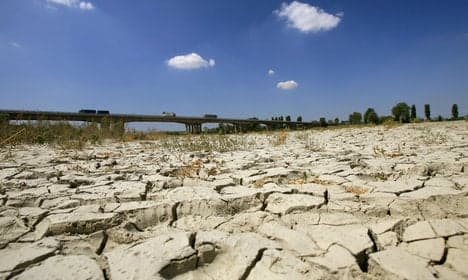Livelihoods at risk as River Po runs dry

Italy's longest river is drying up fast, putting the livelihoods of many along its banks at risk.
As a month-long heatwave grips Italy, levels of water in the river have plunged to 60cm in some areas of Lombardy.
Hydrometric data reveals the Po's levels are way below average, with La Repubblica reporting that in areas around the town of Mantua the main water channel contained no more than 60cm of water.
Current levels have not yet reached the record lows recorded in 2003 and 2006, but with hot weather set to continue, it looks likely that they will be broken again this year.
The average discharge of the Po is 1,540 cubic metres per second, but the extended period of hot, dry weather means that it currently stands at around 400 cubic metres. If levels drop below 350 cubic metres then sea water could start to invade the Po Delta, a Unesco world heritage site.
Low levels are bad news, not least for boat owners.
While smaller river boats are adept at travelling in the shallowest of waters, larger commercial boats have been forced to cease activity, and are marooned on the dry river bed.
One riverboat captain, Giulian Landri, whose riverboat boat, called Stradivari, offers scenic river cruises told La Repubblica how he had been forced to stop using his boat due to the drought.
“It's on days like these that you understand how important water in the river is,” he said.
“My boat's stuck in the river port at Viadana. I was hoping to take it down to Venice this weekend to celebrate the annual feast day of Redentore.”
But Landri admits that while boat owners may lose some trade and have to pay for mooring, things could be much worse.
“I lose some money,” he added. "But farmers risk losing their years' harvest.”
The 653km long Po drains 70,000 Km2 in Italy and its fertile flood plains are home to a huge amount of the country's agriculture.
The grains and cereals used for pasta, rice for risotto, and grapes for wine are all grown along the banks of the Po, taking up 2.7 billion hectares of land and requiring 17 billion cubic metres of water a year.
Yet according to a case study by professor Antonio Massarutto at Bocconi University in Milan, the Po does not have any drought management plans.
As the hot, dry weather continues, water allocation agreements and emergency methods will be put in place limiting how much water can be taken from the Po, putting harvests at risk.
The first to crop to feel the effects of limited irrigation will be corn, which at this time of the year requires a lot of watering.
Comments
See Also
As a month-long heatwave grips Italy, levels of water in the river have plunged to 60cm in some areas of Lombardy.
Hydrometric data reveals the Po's levels are way below average, with La Repubblica reporting that in areas around the town of Mantua the main water channel contained no more than 60cm of water.
Current levels have not yet reached the record lows recorded in 2003 and 2006, but with hot weather set to continue, it looks likely that they will be broken again this year.
The average discharge of the Po is 1,540 cubic metres per second, but the extended period of hot, dry weather means that it currently stands at around 400 cubic metres. If levels drop below 350 cubic metres then sea water could start to invade the Po Delta, a Unesco world heritage site.
Low levels are bad news, not least for boat owners.
While smaller river boats are adept at travelling in the shallowest of waters, larger commercial boats have been forced to cease activity, and are marooned on the dry river bed.
One riverboat captain, Giulian Landri, whose riverboat boat, called Stradivari, offers scenic river cruises told La Repubblica how he had been forced to stop using his boat due to the drought.
“It's on days like these that you understand how important water in the river is,” he said.
“My boat's stuck in the river port at Viadana. I was hoping to take it down to Venice this weekend to celebrate the annual feast day of Redentore.”
But Landri admits that while boat owners may lose some trade and have to pay for mooring, things could be much worse.
“I lose some money,” he added. "But farmers risk losing their years' harvest.”
The 653km long Po drains 70,000 Km2 in Italy and its fertile flood plains are home to a huge amount of the country's agriculture.
The grains and cereals used for pasta, rice for risotto, and grapes for wine are all grown along the banks of the Po, taking up 2.7 billion hectares of land and requiring 17 billion cubic metres of water a year.
Yet according to a case study by professor Antonio Massarutto at Bocconi University in Milan, the Po does not have any drought management plans.
As the hot, dry weather continues, water allocation agreements and emergency methods will be put in place limiting how much water can be taken from the Po, putting harvests at risk.
The first to crop to feel the effects of limited irrigation will be corn, which at this time of the year requires a lot of watering.
Join the conversation in our comments section below. Share your own views and experience and if you have a question or suggestion for our journalists then email us at [email protected].
Please keep comments civil, constructive and on topic – and make sure to read our terms of use before getting involved.
Please log in here to leave a comment.